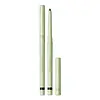What's inside
What's inside
 Key Ingredients
Key Ingredients

 Benefits
Benefits

 Concerns
Concerns

 Ingredients Side-by-side
Ingredients Side-by-side

Cyclopentasiloxane
EmollientPolybutene
Polyethylene
AbrasiveEuphorbia Cerifera Wax
Silica Silylate
EmollientMicrocrystalline Wax
Emulsion StabilisingHydrogenated Jojoba Oil
AbrasiveOctyldodecanol
EmollientSucrose Tetrastearate Triacetate
EmollientTheobroma Grandiflorum Seed Butter
Skin ConditioningCaprylic/Capric Triglyceride
MaskingPentaerythrityl Tetra-Di-T-Butyl Hydroxyhydrocinnamate
AntioxidantChamomilla Recutita Flower Extract
MaskingIron Oxides
Mica
Cosmetic ColorantCI 77266
Cosmetic ColorantCI 77510
Cosmetic ColorantCyclopentasiloxane, Polybutene, Polyethylene, Euphorbia Cerifera Wax, Silica Silylate, Microcrystalline Wax, Hydrogenated Jojoba Oil, Octyldodecanol, Sucrose Tetrastearate Triacetate, Theobroma Grandiflorum Seed Butter, Caprylic/Capric Triglyceride, Pentaerythrityl Tetra-Di-T-Butyl Hydroxyhydrocinnamate, Chamomilla Recutita Flower Extract, Iron Oxides, Mica, CI 77266, CI 77510
Cyclopentasiloxane
EmollientPolybutene
Synthetic Wax
AbrasiveSilica Silylate
EmollientCandelilla Cera
EmollientCera Microcristallina
Emulsion StabilisingHydrogenated Jojoba Oil
AbrasiveOctyldodecanol
EmollientSucrose Tetrastearate Triacetate
EmollientTheobroma Grandiflorum Seed Butter
Skin ConditioningButyrospermum Parkii Butter
Skin ConditioningCeramide NP
Skin ConditioningSimmondsia Chinensis Seed Oil
EmollientEthylhexyl Palmitate
EmollientSilica Dimethyl Silylate
EmollientButylene Glycol
HumectantCaprylyl Glycol
EmollientHexylene Glycol
EmulsifyingSodium Hyaluronate
HumectantPentaerythrityl Tetra-Di-T-Butyl Hydroxyhydrocinnamate
AntioxidantPhenoxyethanol
PreservativeIron Oxides
CI 77163
Cosmetic ColorantMica
Cosmetic ColorantCyclopentasiloxane, Polybutene, Synthetic Wax, Silica Silylate, Candelilla Cera, Cera Microcristallina, Hydrogenated Jojoba Oil, Octyldodecanol, Sucrose Tetrastearate Triacetate, Theobroma Grandiflorum Seed Butter, Butyrospermum Parkii Butter, Ceramide NP, Simmondsia Chinensis Seed Oil, Ethylhexyl Palmitate, Silica Dimethyl Silylate, Butylene Glycol, Caprylyl Glycol, Hexylene Glycol, Sodium Hyaluronate, Pentaerythrityl Tetra-Di-T-Butyl Hydroxyhydrocinnamate, Phenoxyethanol, Iron Oxides, CI 77163, Mica
Ingredients Explained
These ingredients are found in both products.
Ingredients higher up in an ingredient list are typically present in a larger amount.
Cyclopentasiloxane, or D5, is a silicone used to improve texture of products and trap moisture.
D5 is considered lightweight and volatile. Volatile means it evaporates quickly after application. Once evaporated, D5 leaves a thin barrier that helps keep skin hydrated.
It is also an emollient. Emollients help soften the skin and prevent water loss. Silicones create a silky texture in products. D5 helps other ingredients become more spreadable.
Studies show D5 is safe to use in skincare products. We recommend speaking with a skincare professional if you have concerns.
Learn more about CyclopentasiloxaneHydrogenated Jojoba Oil is created from the process of converting jojoba oil to a solid or semi-solid. Jojoba oil has occlusive and emollient properties, making it a great hydrator.
Due to the solid structure of this ingredient, it provides abrasive or exfoliating properties.
This ingredient may not be fungal acne safe.
Learn more about Hydrogenated Jojoba OilMica is a naturally occurring mineral used to add shimmer and color in cosmetics. It can also help improve the texture of a product or give it an opaque, white/silver color.
Serecite is the name for very fine but ragged grains of mica.
This ingredient is often coated with metal oxides like titanium dioxide. Trace amounts of heavy metals may be found in mica, but these metals are not harmful in our personal products.
Mica has been used since prehistoric times throughout the world. Ancient Egyptian, Indian, Greek, Roman, Aztec, and Chinese civilizations have used mica.
Learn more about MicaOctyldodecanol is a fatty alcohol. It is primarily used to enhance the texture of products.
As an emulsifier, Octyldodecanol helps prevent the oils and waters from separating. It also prevents ingredients from creating foam when shaken.
Octyldodecanol is created by reducing fatty acid to an alcohol.
Due to its high molecular weight, it does not get absorbed into the skin.
Learn more about OctyldodecanolPentaerythrityl Tetra-Di-T-Butyl Hydroxyhydrocinnamate (long name, huh?) is a synthetic antioxidant.
It is used to help stabilize other antioxidants or prevent the color from changing in a product.
As an antioxidant, it helps fight free-radical molecules. Free-radical molecules are capable of damaging our cells and other genetic material. Thus, antioxidants may reduce the signs of aging.
This ingredient is oil-soluble.
Learn more about Pentaerythrityl Tetra-Di-T-Butyl HydroxyhydrocinnamatePolybutene is used to help control the viscosity of a product. This just means it helps adjusts the texture.
It is a polymer and does not get absorbed into the skin due to its large size.
Studies found this ingredient did not irritate skin in concentrations below 15%.
Learn more about PolybuteneSilica Silylate is a siloxane polymer, meaning it is made up of silicon and oxygen atoms. It is not soluble in water.
This ingredient is a white powder with oil-absorbing, emollient, and anticaking properties.
Sucrose Tetrastearate Triacetate isn't fungal acne safe.
Theobroma Grandiflorum Seed Butter isn't fungal acne safe.
This ingredient is a combination of red, black, and yellow iron oxide pigments. This combination of colors is usually found in foundation, because it results in a "skin" color.